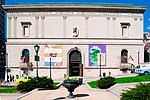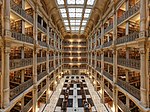C. Grimaldis Gallery

The C. Grimaldis Gallery is a contemporary and modern art gallery established in 1977 by Constantine Grimaldis. It is the longest continually operating gallery in Baltimore, Maryland. The gallery specializes in post-WWII American and European art with an emphasis on contemporary sculpture. In addition to representing approximately 40 nationally and internationally established artists, the gallery is responsible for the estates of Grace Hartigan and Eugene Leake. The gallery has been responsible for hundreds of important solo and group exhibitions that have launched and sustained the careers of many artists from the United States and abroad. "Grimaldis began in 1977 by exhibiting mostly artists with a regional reputation, but gradually added major New York names to the roster and made his gallery one always worth following." Noteworthy artists to have exhibited at C. Grimaldis Gallery include John Baldessari, Sir Anthony Caro, Elaine de Kooning, Willem de Kooning, Grace Hartigan, Hans Hoffman, Beverly McIver, Alice Neel, Robert Rauschenberg, Richard Serra, Joel Shapiro, John Van Alstine and John Waters.The gallery produces scholarly catalogues and public programing in support of select exhibitions. Public programming consists of artists talks and expert lectures on current exhibitions which are free and open to the public in the gallery space. In addition to gallery exhibitions and events, C. Grimaldis Gallery participates in an average of six national and international art fairs annually. For over 14 years C. Grimaldis Gallery has participated in various art fairs including Art Miami, Palm Beach 3, Art Chicago, Art Athina and the Houston Fine Art Fair.
Excerpt from the Wikipedia article C. Grimaldis Gallery (License: CC BY-SA 3.0, Authors, Images).C. Grimaldis Gallery
North Charles Street, Baltimore
Geographical coordinates (GPS) Address External links Nearby Places Show on map
Geographical coordinates (GPS)
| Latitude | Longitude |
|---|---|
| N 39.295944444444 ° | E -76.615444444444 ° |
Address
C. Grimaldis Gallery
North Charles Street 523
21201 Baltimore
Maryland, United States
Open on Google Maps











